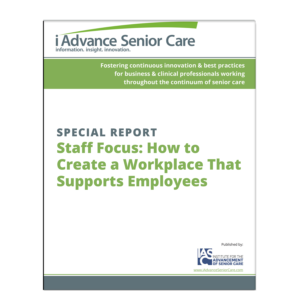What are you doing to retain staff?
As an ombudsman volunteer for the past six plus years, I have witnessed the effects of short staffing and have also heard many of the complaints attributed to it. You probably don’t really care what an ombudsman volunteer has to say, but hear me out.
I recently completed my doctoral dissertation and was awarded my PhD (2007)in the applied technology and performance improvement field. The objective of the performance improvement field is to improve the productivity and performance in the workplace through management initiatives/change, technology innovations, outsourcing, or globalization. My study focused on the perceptions of nursing assistants (NAs) working in state-owned veterans long-term care (LTC) facilities regarding factors that could induce them to quit: Basically a staff retention study. The goal of the research was to see what (if anything) could be done to improve the retention rates of these particular NAs.
I selected this topic because of my frustration with the constant loss of NAs in the facility where I was assigned as an ombudsman volunteer. The residents of LTC facilities deserve great care and the NA is the frontline worker. If there is constant turnover, it is hard for the residents to establish a routine and receive the care they want and, at times, the care they need. Harrington and Swan1 noted that high turnover rates lowered staffing levels and that nursing facilities needed to place emphasis on staff retention. Furthermore, by focusing their efforts on retention and staff by addressing factors related to turnover and wages, stability of their workforce may result. Cohen-Mansfield emphasized that “before any attempt is made to reduce high turnover, administration must be aware of areas of concern to nursing staff.”2
Surveying staff
I was given permission to study all the state-owned veterans LTC facilities located in a Midwest state. I traveled that state and administered my survey to more than 400 NAs. The results were mixed; some were the same old issues-more pay, better working conditions-but others were interesting and indicated that a small correction in administrative policy might help to reduce turnover. A good example is the policy that allows only monthly pay periods. My study indicated that more than half of the NAs I surveyed were not satisfied (by varying degrees) with the current monthly pay period. With today’s technology, people should be able to be paid whenever they want. The greater issue with this policy happened when an employee was hired after the 12
th of the month because they would not see any pay until six weeks later. Clearly, this was one policy that needed to be fixed.
So, what is an employer to do to keep their employees? Do you use exit interviews to try and find out why your employees are leaving? Have you considered that exit interviews might not be a good method, especially if the employees are not leaving voluntarily? Some employees may have an axe to grind. On the other hand, exit interviews that try to determine why good employees are leaving should provide useful information. Instead of trying to determine why employees are leaving, a better approach might be to use a satisfaction survey to find out why your current employees are staying. After analyzing the results, you might be able to tailor a benefit package to keep more of these employees on board.
A great many issues must be considered before you survey staff, such as the frequency of previous staff surveys you may have administered, the number of answer choices for each survey question, and the length of the survey. But probably two of the more important issues to consider are (1) who will be asked to complete the survey and (2) who will administer it. Simply selecting the day shift and asking them to answer the questions results in answers applicable to the day shift only. If you preselect the NAs who will answer the questions, the answers will be applicable to only those individuals. In the research world, this is called a “convenience sample,” which is not optimal.
Who administers the survey is extremely important. If a facility employee administers the survey, how are you ensuring the NAs of confidentiality? Can their answers be traced back to them? Probably a more important issue is whether the aides feel that their answers cannot be traced back to them. During my data collection, the aides only knew that I was conducting a study that could benefit them. I did not work for the organization and they were assured that all their responses would be kept confidential. I even had a form explaining the process. I think they were relieved that I was the only person who would see the actual surveys and that no marks were made that could identify them. I note this because in some of the facilities I traveled to, the staff was surveyed often and yet there were still high turnover rates. I must mention that in these cases the surveys were administered by in-house staff. My question then becomes: Are you frequently surveying the aides and receiving answers that you are a great facility, but the turnover is still out of control? If so, have you considered that maybe the staff is answering questions the way they feel you want them to?
Devising questions
As I learned early on in the pursuit of my doctorate, nothing is as easy or straightforward as it may seem. The importance of this statement is vital in the selection of the material to survey the NAs or the target population in any study. Simply making up some questions and getting answers does not work very well. There has to be some check of the questions to ensure that they are measuring what is intended to be measured. A good source of survey questions is located in the U.S. Department of Health and Human Services and U.S. Department of Labor guide, Measuring Long-Term Care Work: A Guide to Selected Instruments to Examine Direct Care Worker Experiences and Outcomes.3
Many surveys are assigned a number, usually .80 or something similar. This number is the reliability coefficient and many people mistakenly think this number applies to their survey. This is incorrect. The number applies to the previous use(s) of the survey and not the survey or its participants. This means that just because the previous user(s) had a high number, you don’t automatically get that reliability number. It is very important to determine the reliability coefficient of your population to determine whether there is consistency in the responses or whether they are way off track. Generally a .70 or higher is acceptable, but some sources require .80 or higher to be considered reliable. If you achieve a number lower than .70, then you might have what are called “outliers” and you need to find them through the use of a scatterplot and determine whether they are an anomaly or genuinely part of the sample. Take the time to do the process correctly and the results might surprise you. In my case, simply changing the pay period from monthly to bimonthly may keep more of the staff. This policy has since been changed to allow bi-monthly pay periods.
The odds are pretty good that you don’t have staff trained in the particulars of reliability coefficients. A local university might have a graduate student or new professor who would love to conduct the survey and run the analyses for free. He or she might ask if the results can be published since new professors need to publish articles or they perish. If I have not convinced you that doing the survey process correctly is a worthwhile endeavor, consider the next paragraph and ask yourself if you are prepared.
Anticipating staff requirements
A noteworthy statistic located in the Bureau of Labor Statistics’ Occupational Outlook Handbook, 2010-2011 edition, indicated that the nursing industry has experienced growth in employment in the LTC field signifying that possibly the beginning of the estimated 76 million aging baby boomers born between the years 1946 to 1964 are beginning to retire.4 The U.S. government is projecting a 250% increase in the elderly population and staffing these nursing homes and related facilities are a critical concern. In 2000, individuals aged 65 or older numbered 35.1 million, accounting for 12.4% of the U.S. population. By 2020, the percentage of individuals aged 65 or older is projected to increase to 16.3%, equaling one in six Americans. This will result in an increase of 20 million more elderly than in the year 2000. By 2040, the number of persons aged 85 years and older is projected to increase more than 250% from 4.3 million in 2000 to 15.4 million.4
With the projected population increases and the increased demand for LTC services, staff requirements in nursing and residential care facilities are expected to dramatically increase. A vitally important but often overlooked factor of the LTC industry is employee turnover. Turnover NAs has been estimated at more than 100%.5 For registered nurses (RNs) and licensed vocational nurses (LVNs), turnover rates range between 40 and 70%.5 This is in part fueled by financial pressures on hospitals to discharge patients as soon as possible and modern medical technology. As technology saves and extends more lives, it increases the need for long-term care.6
As Paul Willging noted in his article, “Just who will take care of mom and dad,” (Nursing Homes/Long Term Care Management, October 2007, p. 16), how much money are you losing each year due to turnover? Have you run the numbers to see what your monthly losses are because of turnover and constant retraining? Remember, every new hire needs at least some on-the-job training in your facility. Having two people do the work of one does not help the bottom line. Money spent to constantly train new employees could be better used to purchase equipment, which would make the nurse’s aides’ job easier.
Chris Wike, PhD, MBA, is a full-time freelance academic teaching business, finance, leadership, organizational theory, human resource management, and information technology management classes. He can be reached at (580) 713-0296 or e-mail
Christopher.Wike@Wayland.wbu.edu or
To send your comments to the editor, e-mail mhrehocik@iadvanceseniorcare.com.
References
- Harrington C, Swan JH. Nursing home staffing, turnover, and case mix. Medical Care Research and Review 2003; 60:366-92.
- Cohen-Mansfield J. Turnover among nursing home staff. Nursing Management 1997; 28; 59-64.
- U.S. Department of Health and Human Services and U.S. Department of Labor. Measuring long-term care work: A guide to selected instruments to examine direct care worker experiences and outcomes. April 2005. Available at:https://aspe.hhs.gov/daltcp/reports/dcwguide.pdf
- U.S. Government Accountability Office. Long-term care financing: Growing demand and cost of services are straining Federal and State budgets (Report No. GAO-05-564T), 2005. Washington, DC:Government Accountability Office.
- American Health Care Association. Results of the 2001 AHCA Nursing Position Vacancy and Turnover Survey, 2002. Washington, DC:AHCA, Health Services Research and Evaluation.
- Bureau of Labor Statistics, U.S. Department of Labor. Occupational Outlook Handbook, 2010-11 ed. Nursing and Psychiatric Aides. Available at:https://www.bls.gov/oco/ocos327.htm
Long-Term Living 2010 April;59(4):36-37
I Advance Senior Care is the industry-leading source for practical, in-depth, business-building, and resident care information for owners, executives, administrators, and directors of nursing at assisted living communities, skilled nursing facilities, post-acute facilities, and continuing care retirement communities. The I Advance Senior Care editorial team and industry experts provide market analysis, strategic direction, policy commentary, clinical best-practices, business management, and technology breakthroughs.
I Advance Senior Care is part of the Institute for the Advancement of Senior Care and published by Plain-English Health Care.
Related Articles
Topics: Articles , Staffing











